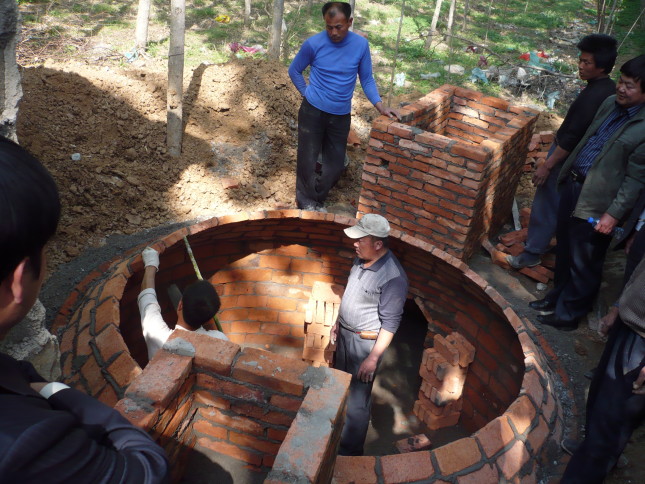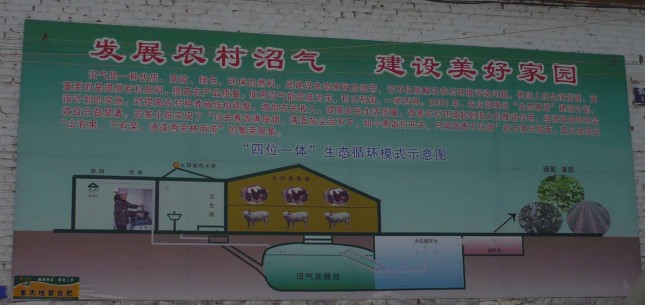-
Capturing Greenhouse Gases in China’s Countryside
June 11, 2020 By Karen Mancl
Spreading manure on crops recycles the nutrients, but as it decomposes it releases methane. And lots of it. Agriculture is the largest source of methane emissions globally. Each year, methane from livestock manure has the warming equivalent of 240 million tons of carbon dioxide, or the same as the annual emissions from 52 million cars. One of the most effective ways of mitigating this powerful greenhouse gas is to capture it and burn it as natural gas. The Chinese government has been incentivizing farmers to do this for decades and the United States has too, albeit less successfully.
In the United States, nearly half of the methane released from manure comes from pig farms. Compared to China, the United States has viewed methane capture as a low priority and is way behind adopting it in agriculture. Only 3 percent of U.S. dairy and swine farms operate anaerobic digesters to capture methane.

Responding to Energy Crises
The oil crisis of 1979 was a wake-up call for U.S. policy makers. Oil prices shot up threefold, creating gas shortages and long lines at filling stations. Support for alternative energy research peaked in the early 1980s but quickly disappeared as oil prices dropped back to pre-crisis levels.
In the United States, agricultural universities started conducting research and constructed about 140 farm digesters. Sadly, by the mid-1980s, 85 percent of the early U.S. digesters were abandoned when fuel prices dropped. Farmers went back to storing and spreading untreated manure that continued to release methane into the atmosphere.
Around the same period, China was facing another type of energy crisis – firewood. In the countryside, peasants gathered wood to fuel their stoves, devastating the nation’s forests and creating a massive human health crisis. A central government funded research effort was mounted to find an alternative fuel that would allow for the preparation of three meals per day and limit harmful smoke. Methane captured from the breakdown of manure looked promising.
In 1979, the Ministry of Agriculture created the Biogas Institute in Chengdu, located in the country’s agricultural heartland. Researchers there helped develop low-cost, cement and brick fixed dome digesters. Research and demonstration projects took off and by 1983 China had seven million rural homes (about 3.5 percent) operating anaerobic digesters.
The Chinese Biogas Institute continued to build its program and in 1981 established the Asia-Pacific Training Center to teach tradesmen how to construct and maintain the small brick digesters. Through the years, this training center has reached 55 countries, making China a rural biogas technology transfer leader in the Indo-China region.
Renewed Interest in Methane Capture
In the late 1990s, interest was renewed in methane in both the United States and China, not only for fuel, but also to reduce greenhouse gas emissions. Construction of more household digesters ramped up in China and under the 2003 Ministry of Agriculture National Rural Biogas Construction Plan and the 2006 National Development and Reform Commission Renewable Energy Plan, the goal was set at a total of 40 million digesters by 2010. More than 70,000 people were employed to promote and build biogas digesters. These household digesters are now the largest producers of methane biogas, with 43 million in place by 2013. Construction started to slow down in 2011, shifting the new growth in methane capture to medium and large agricultural digesters at more concentrated animal feeding operations.

To help meet China’s goal, subsidies for half of the digester cost were made available. The subsidy varied by region with the poor, western areas getting the highest amount. The money, however, came with strings attached. Under the new One-plus-Three Renovation requirement, the money had to be used to construct the digester and upgrade the livestock pen, toilet, and kitchen. In 2014, the central and local governments invested 2.5 billion yuan (US$35 million) in digester engineering and construction.
The United States has taken a more modest approach to capturing methane from agriculture. The AgSTAR program started in 2000 as a joint effort between the Department of Agriculture (USDA), the Environmental Protection Agency (EPA), and the Department of Energy. USDA has provided 107 grants through the Rural Energy for America program under the 2014 Farm Bill and the EPA promotes the program. By 2019, the United States had 254 agricultural biogas digesters.
Multiple Benefits
China’s success in methane capture comes from a focus on the many benefits of anaerobic digestion. Everywhere the fuel value of the biogas is not enough to cover the cost of construction and digester management. However, the use of biogas stoves has removed the pressure on China’s forests and reduced the reliance on firewood. Burning less wood, straw, and coal has improved indoor air quality and especially positively impacted the health of women. Digesting manure is a form of waste treatment that reduces odors, pathogens, and waste volume. Remarkably, the digested manure still retains the nutrient content to fertilize crops. Since nearly 10 tons of CO2 is released to produce 1 ton of chemical fertilizer, replacing that with digested manure as an organic fertilizer further enhances greenhouse gas reduction.
China is leading the world in using digesters to capture methane from manure, accounting for a third of the global total. China has also modelled the elements of a successful agricultural methane capture program for developing and developed countries. The Biogas Institute provides a comprehensive program of research, technical support, training, and demonstration combined with government subsidies.
Most importantly, China recognized early the multiple benefits of adopting biogas technology. The fuel value may rise and fall with world energy markets, but greenhouse gas reduction, forest protection, and improved indoor air quality and disease control ensure a strong package of environmental and public health benefits.
Karen Mancl is a Professor of Food, Agricultural and Biological Engineering at The Ohio State University and Director of the OSU Soil Environment Technology Learning Lab. In 2020, she is working as a research assistant in the Woodrow Wilson’s China Environment Forum. She holds a PhD in Water Resources from Iowa State University and an MA in East Asian Studies and an MA in Public Policy from Ohio State University.
Sources: AgSTAR, Biocycle, Biogas Institute of the Ministry of Agriculture, CERDI, Congressional Research Service, Energypedia, Environmental and Energy Study Institute, European Biogas Association, FAO, Federal Reserve History, International Institute for Environment and Development, Journal of Environmental Management, Petroleum Science, Thorax, UMass Law Review, USDA Rural Development, U.S. EPA, World Development
Lead photo caption: Training program in biogas digester construction in Shandong Province. Photo courtesy of the author.
 A Publication of the Stimson Center.
A Publication of the Stimson Center.





